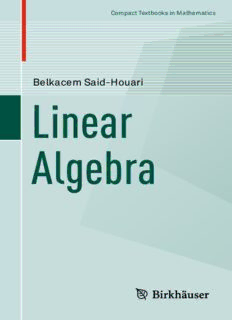
Linear Algebra PDF
Preview Linear Algebra
Compact Textbooks in Mathematics Belkacem Said-Houari Linear Algebra CompactTextbooksinMathematics CompactTextbooksinMathematics This textbook series presents concise introductions to current topics in mathematicsandmainlyaddressesadvancedundergraduatesandmaster students. The concept is to offer small books covering subject matter equivalentto2-or3-hourlecturesorseminarswhicharealsosuitablefor self-study.Thebooksprovidestudentsandteacherswithnewperspectives andnovelapproaches. Theyfeatureexamplesandexercisestoillustrate key concepts and applications of the theoretical contents. The series also includes textbooks specifically speaking to the needs of students fromotherdisciplinessuchasphysics,computerscience,engineering,life sciences,finance. (cid:2) compact:smallbookspresentingtherelevantknowledge (cid:2) learningmadeeasy:examplesandexercisesillustratetheapplication ofthecontents (cid:2) usefulforlecturers:eachtitlecanserveasbasisandguidelinefora semestercourse/lecture/seminarof2–3hoursperweek. Moreinformationaboutthisseriesathttp://www.springer.com/series/11225 BelkacemSaid-Houari Linear Algebra BelkacemSaid-Houari DepartmentofMathematics,CollegeofSciences UniversityofSharjah Sharjah,UnitedArabEmirates ISSN2296-4568 ISSN2296-455X (electronic) CompactTextbooksinMathematics ISBN978-3-319-63792-1 ISBN978-3-319-63793-8 (eBook) DOI10.1007/978-3-319-63793-8 LibraryofCongressControlNumber:2017951442 MathematicsSubjectClassification(2010):15A03,15A04,15A18,15A42,15A63,15B10,11C20, 11E16 ©SpringerInternationalPublishingAG2017 Thisworkissubjecttocopyright.AllrightsarereservedbythePublisher,whetherthewhole orpartofthematerialisconcerned,specificallytherightsoftranslation,reprinting,reuse ofillustrations,recitation,broadcasting,reproductiononmicrofilmsorinanyotherphysical way,andtransmissionorinformationstorageandretrieval,electronicadaptation,computer software,orbysimilarordissimilarmethodologynowknownorhereafterdeveloped. Theuseofgeneraldescriptivenames,registerednames,trademarks,servicemarks,etc.inthis publicationdoesnotimply,evenintheabsenceofaspecificstatement,thatsuchnamesare exemptfromtherelevantprotectivelawsandregulationsandthereforefreeforgeneraluse. Thepublisher,theauthorsandtheeditorsaresafetoassumethattheadviceandinformation inthisbookarebelievedtobetrueandaccurateatthedateofpublication.Neitherthe publishernortheauthorsortheeditorsgiveawarranty,expressorimplied,withrespect tothematerialcontainedhereinorforanyerrorsoromissionsthatmayhavebeenmade. Thepublisherremainsneutralwithregard tojurisdictionalclaimsinpublishedmapsand institutionalaffiliations. Printedonacid-freepaper ThisbookispublishedunderthetradenameBirkhäuser,www.birkhauser-science.com TheregisteredcompanyisSpringerInternationalPublishingAG Theregisteredcompanyaddressis:Gewerbestrasse11,6330Cham,Switzerland To mydaughterNOUR vii Preface Linear algebra is the study of the algebraic properties of linear transfor- mations and matrices and it is an essential part of virtually all areas of mathematics.Itisalsoafundamentalandanextremelypowerfultoolinevery singledisciplineofsciencesandengineering. This is a self-contained textbook on linear algebra written in an easy way, so that it can be accessible to many readers. It begins in (cid:2) Chap. 1 with the simplest linear equation and generalizes many notions about this equationtosystemsoflinearequations,andthenintroducesthemainideas usingmatricesandtheirproperties.Webelievethatthisistherightapproach, since moststudents take the first courseof linear algebra already knowing something about linear equations, lines, and systems of linear equations. Then follows a detailed chapter ((cid:2) Chap. 2) on determinants and their properties where we also study the relationship between determinants and the inverses of matrices and the use of determinants in solving systems of linearequations.Weintroducethemainideaswithdetailedproofs.Wealso investigatesomeparticulardeterminantsthatareveryusefulinapplications. Inaddition,weexplaininasimplewaywheretheideasofdeterminantscome fromandhowtheyfittogetherinthewholetheory. In(cid:2)Chap.3,weintroducetheEuclideanspacesusingverysimplegeo- metric ideas and then discuss various important inequalities and identities. These ideas are presentin the theory of general Hilbert spaces in a course of functional analysis, so it is much better for students to learn them and understandthemclearlyinEuclideanspaces. Thecoreof(cid:2)Chap.4isadetaileddiscussionofgeneralvectorspaces where rigorous proofs to all the main results in this book are given. This is followed by a chapter ((cid:2) Chap. 5) on linear transformations and their properties. In (cid:2)Chap.6,weintroducenotionsconcerningmatricesthroughlinear transformations, trying to bridge thegap between matrix theory and linear algebra. (cid:2) Chapters 7 and 8 are more advanced, where we introduce all the necessary ideas concerningeigenvaluesand eigenvectorsand thetheory of symmetricandorthogonalmatrices. Oneoftheaspectsthatshouldmakethistextbookusefulforstudentsis the presence of exercises at the end of each chapter. We did choose these exercises very carefully to illustrate the main ideas. Since some of them are taken (with some modifications) from recently published papers, it is possiblethattheseexercises appearfor thefirsttimein atextbook.Allthe exercisesareprovidedwithdetailedsolutionsandineachsolution,werefer tothemaintheoremsinthetextwhennecessary,sostudentscanseethemain tools used in the solution.In addition all the mainideasinthisbookcome viii Preface with illustrating examples. We did strive to choose solutions and proofs that are elegant and short. We also tried to make this textbook in about 400 pages by focusing on the main ideas, so that students will be able to easily and quickly understand things. In addition, we tried to maintain a balance between the theory of matrices and the one of vector spaces and lineartransformations. Thisbookcanbeusedasatextbookforafirstcourseinlinearalgebrafor undergraduatestudentsinalldisciplines.Itcanbealsousedasabookletfor graduatestudents,allowingto acquire someconcepts, examples,and basic results.Itisalsosuitableforthosestudentswhoarelookingforsimple,easy, andcleartextbookthatsummarizesthemainideasoflinearalgebra.Finally itisalsointendedforthosestudentswhoareinterestedinrigorousproofsof themaintheoremsinlinearalgebra.Webelievethatifagoodstudentuses thisbook,thenshe(he)canreadandlearnthebasicsoflinearalgebraonher (his)own. WewouldliketothankSalimA.Messaoudi(fromKFUPM)forvaluable suggestionsand corrections which improved the contents of some parts of thisbook.WealsothankSofianeBouarroudj(fromNYUAbuDhabi)forthe many discussions that we have had about the proofs of some theorems of linearalgebra. AbuDhabi,UnitedArabEmirates BelkacemSaid-Houari October06,2016 ix Contents 1 MatricesandMatrixOperations................................ 1 BelkacemSaid-Houari 1.1 SystemsofLinearEquations........................................ 1 1.1.1 TheGroupofMatrices............................................... 11 1.1.2 MultiplicationofMatrices ........................................... 12 1.2 SquareMatrices.................................................... 19 1.2.1 TheRingofSquareMatrices......................................... 19 1.2.2 TheIdentityMatrix.................................................. 21 1.2.3 InverseMatrices..................................................... 22 1.2.4 DiagonalMatrices................................................... 30 1.2.5 TriangularMatrices.................................................. 35 1.2.6 Trace................................................................ 37 1.3 SolvingLinearSystemswithElementaryRowOperations .......... 39 1.3.1 TheGauss–JordanEliminationMethod .............................. 41 1.4 TheMatrixTransposeandSymmetricMatrices ..................... 49 1.4.1 TransposeofaMatrix................................................ 50 1.4.2 SymmetricMatrices................................................. 52 1.5 Exercises ........................................................... 53 2 Determinants..................................................... 69 BelkacemSaid-Houari 2.1 Introduction........................................................ 69 2.2 DeterminantsbyCofactorExpansion............................... 70 2.3 PropertiesoftheDeterminants .................................... 76 2.4 EvaluatingDeterminantsbyRowReduction........................ 79 2.4.1 DeterminantTestforInvertibility .................................... 89 2.5 TheAdjointofaSquareMatrix ..................................... 91 2.5.1 Cramer’sRule ....................................................... 99 2.6 Exercises ........................................................... 104 3 EuclideanVectorSpaces......................................... 121 BelkacemSaid-Houari 3.1 Introduction........................................................ 121 3.2 VectorAdditionandMultiplicationbyaScalar ..................... 121 3.2.1 VectorAddition..................................................... 121 3.2.2 MultiplicationofaVectorbyaScalar................................. 123 3.2.3 VectorsinCoordinateSystems....................................... 123 3.2.4 LinearCombination................................................. 127 3.3 Norm,DotProduct,andDistanceinRn ............................. 128 3.3.1 TheNormofaVectorinRn .......................................... 128 3.3.2 DistanceinRn....................................................... 131 3.3.3 TheDotProductofTwoVectorsinRn................................ 132 x Contents 3.4 OrthogonalityinRn................................................. 141 3.4.1 OrthogonalProjectionsinRn ........................................ 142 3.5 Exercises............................................................ 145 4 GeneralVectorSpaces ........................................... 159 BelkacemSaid-Houari 4.1 DefinitionandExamples............................................ 159 4.2 PropertiesofVectorSpaces......................................... 161 4.3 Subspaces .......................................................... 163 4.3.1 DirectSumDecomposition.......................................... 170 4.4 LinearIndependence ............................................... 172 4.5 BasesofVectorSpaces.............................................. 175 4.6 DimensionofaVectorSpace........................................ 178 4.6.1 DimensionofaSubspace............................................ 182 4.6.2 ConstructionofaBasis............................................... 182 4.7 Exercises............................................................ 183 5 LinearTransformations.......................................... 199 BelkacemSaid-Houari 5.1 DefinitionandExamples ........................................... 199 5.2 FundamentalPropertiesofLinearTransformations................. 201 5.2.1 TheKernelandtheImageofaLinearTransformation ................ 204 5.3 IsomorphismofVectorSpaces...................................... 211 5.4 Exercises............................................................ 215 6 LinearTransformationsandMatrices .......................... 227 BelkacemSaid-Houari 6.1 DefinitionandExamples ........................................... 227 6.2 ChangeofBasisandSimilarity...................................... 234 6.3 RankofMatrices.................................................... 241 6.3.1 SomePropertiesoftheRankofaMatrix.............................. 243 6.4 MethodsforFindingtheRankofaMatrix........................... 246 6.4.1 TheMethodofElementaryRowandColumnOperations ............. 246 6.4.2 TheMethodofMinorsforFindingtheRankofaMatrix ............... 251 6.5 Exercises............................................................ 255 7 EigenvaluesandEigenvectors................................... 269 BelkacemSaid-Houari 7.1 Definitions.......................................................... 269 7.2 PropertiesofEigenvaluesandEigenvectors ........................ 272 7.3 EigenvaluesandEigenvectorsofaMatrix........................... 277 7.4 Diagonalization..................................................... 290 7.4.1 SpectrumofSymmetricMatrices .................................... 296
Description: